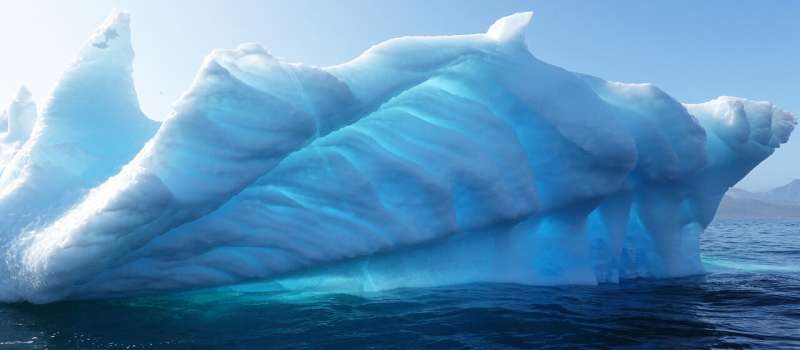How icebergs really melt—and what this could mean for climate change

Icebergs are melting faster than current models describe, according to a new study by mathematicians at the University of Sydney. The researchers have proposed a new model to more accurately represent the melt speed of icebergs into oceans.
Their results, published in Physical Review Fluids, have implications for oceanographers and climate scientists.
Lead author and Ph.D. student Eric Hester said: "While icebergs are only one part of the global climate system, our improved model provides us with a dial that we can tune to better capture the reality of Earth's changing climate."
Current models, which are incorporated into the methodology used by the Intergovernmental Panel on Climate Change, assume that icebergs melt uniformly in ocean currents. However, Mr Hester and colleagues have shown that icebergs do not melt uniformly and melt at different speeds depending on their shape.
"About 70 percent of the world's freshwater is in the polar ice sheets and we know climate change is causing these ice sheets to shrink," said Mr Hester, a doctoral student in the School of Mathematics & Statistics.
"Some of this ice loss is direct from the ice sheets, but about half of the overall ice loss from Greenland and Antarctica happens when icebergs melt in the ocean, so understanding this process is important.
"Our model shows that icebergs are melting at faster rates than current models assume," he said.
As well as its importance for modelling how ice sheets are changing, Mr Hester said his research will help us better understand the impact of ice melt on ocean currents.
"Ocean circulation is the reason that Britain isn't as cold as Alberta, Canada, despite being at similar latitudes," Mr Hester said.
The Gulf Stream that takes warmer water from the tropics across the Atlantic keeps western Europe milder than it otherwise would be, he said.
"That current could shut down if too much freshwater is dumped into the system at once, so it's critical we understand the process of iceberg and ice sheet melt."
Where and when the freshwater is released, and how the ocean is affected, in part depends on the speed at which icebergs melt.
Co-author Dr. Geoffrey Vasil from the University of Sydney said: "Previous work incorporating icebergs in climate simulations used very simple melting models. We wanted to see how accurate those were and whether we could improve on them."
Mr Hester said their models—confirmed in experiment—and the observations of oceanographers show that the sides of icebergs melt about twice as fast as their base. For icebergs that are moving in the ocean, melting at the front can be three or four times faster than what the old models predicted.
"The old models assumed that stationary icebergs didn't melt at all, whereas our experiments show melting of about a millimetre every minute," Mr Hester said.
"In icebergs moving in oceans, the melting on the base can be up to 30 percent faster than in old models."
The research shows that iceberg shape is important. Given that the sides melt faster, wide icebergs melt more slowly but smaller, narrower icebergs melt faster.
"Our paper proposes a very simple model that accounts for iceberg shape, as a prototype for an improved model of iceberg melting," Dr. Vasil said.
To test these models, the researchers developed the first realistic small-scale simulations of melting ice in salt water.
"We are confident this modelling captures enough of the complexity so that we now have a much better way to explain how icebergs melt," Mr Hester said.
Dr. Vasil, who is Mr Hester's Ph.D. supervisor, said: "Before Eric started his Ph.D. the computational tools to model these kinds of systems didn't really exist.
"Eric took a very simple prototype and made it work wonderfully on the complex ice-melting problem."
Dr. Vasil said that these methods can be applied to many other systems, including glaciers melting or the melting of frozen, saline sea ice.
"But it doesn't end there. His methods could also be used by astrobiologists to better understand ice moons like Saturn's Enceladus, a candidate for finding life elsewhere in the Solar System."
More information: Eric W. Hester et al. Aspect ratio affects iceberg melting, Physical Review Fluids (2021). DOI: 10.1103/PhysRevFluids.6.023802
Provided by University of Sydney





















